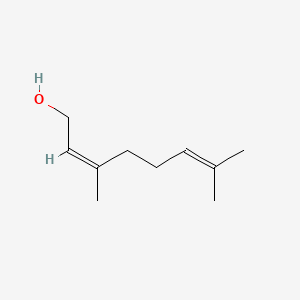| Authors | Title | Published | Journal | PubMed Link |
|---|---|---|---|---|
| Messaoud C and Boussaid M | Myrtus communis berry color morphs: a comparative analysis of essential oils, fatty acids, phenolic compounds, and antioxidant activities. | 2011 | Chem. Biodivers. | pmid:21337502 |
| Rekha KR and Selvakumar GP | Gene expression regulation of Bcl2, Bax and cytochrome-C by geraniol on chronic MPTP/probenecid induced C57BL/6 mice model of Parkinson's disease. | 2014 | Chem. Biol. Interact. | pmid:24768735 |
| Seo KA et al. | The monoterpenoids citral and geraniol are moderate inhibitors of CYP2B6 hydroxylase activity. | 2008 | Chem. Biol. Interact. | pmid:18611395 |
| Goettmann F et al. | Hybrid bidentate ligand for functional recognition: an application to regioselective C=C double bond hydrogenation. | 2006 | Chem. Commun. (Camb.) | pmid:16767267 |
| Shibuya H et al. | Chemical transformation of terpenoids. X. Ionophoretic activities of macrocyclic lactone epoxides synthesized from geraniol. | 1994 | Chem. Pharm. Bull. | pmid:8149455 |
| Fukuda T et al. | Two new monoterpene glycosides from ku-ding-cha. Inhibitors of acyl-CoA: cholesterol acyltransferase (ACAT). | 1996 | Chem. Pharm. Bull. | pmid:8945784 |
| Hagvall L et al. | Fragrance compound geraniol forms contact allergens on air exposure. Identification and quantification of oxidation products and effect on skin sensitization. | 2007 | Chem. Res. Toxicol. | pmid:17428070 |
| Cain WS et al. | Comparison of models of odor interaction. | 1995 | Chem. Senses | pmid:8788096 |
| Carlsson MA and Hansson BS | Dose-response characteristics of glomerular activity in the moth antennal lobe. | 2003 | Chem. Senses | pmid:12771013 |
| Takiguchi N et al. | Performance of mice in discrimination of liquor odors: behavioral evidence for olfactory attention. | 2008 | Chem. Senses | pmid:18178544 |
| Soh Z et al. | An artificial neural network approach for glomerular activity pattern prediction using the graph kernel method and the gaussian mixture functions. | 2011 | Chem. Senses | pmid:21343242 |
| Jordan MD et al. | Odorant receptors from the light brown apple moth (Epiphyas postvittana) recognize important volatile compounds produced by plants. | 2009 | Chem. Senses | pmid:19293399 |
| Riclea R and Dickschat JS | The absolute configuration of the pyrrolosesquiterpenoid glaciapyrrol A. | 2011 | Chemistry | pmid:21901770 |
| Johansen JD et al. | Content and reactivity to product perfumes in fragrance mix positive and negative eczema patients. A study of perfumes used in toiletries and skin-care products. | 1997 | Contact Derm. | pmid:9237007 |
| Rastogi SC et al. | Deodorants on the European market: quantitative chemical analysis of 21 fragrances. | 1998 | Contact Derm. | pmid:9504243 |
| Frosch PJ et al. | Patch testing with fragrances: results of a multicenter study of the European Environmental and Contact Dermatitis Research Group with 48 frequently used constituents of perfumes. | 1995 | Contact Derm. | pmid:8565489 |
| Hagvall L et al. | Contact allergy to air-exposed geraniol: clinical observations and report of 14 cases. | 2012 | Contact Derm. | pmid:22681463 |
| Tamagawa-Mineoka R et al. | Allergic contact cheilitis due to geraniol in food. | 2007 | Contact Derm. | pmid:17343631 |
| Rastogi SC et al. | Natural ingredients based cosmetics. Content of selected fragrance sensitizers. | 1996 | Contact Derm. | pmid:8879930 |
| Romaguera C et al. | Geraniol dermatitis. | 1986 | Contact Derm. | pmid:2940065 |
Nerol
Nerol is a lipid of Prenol Lipids (PR) class. The involved functions are known as Odorant, Anabolism, Diastasis, Metabolic Inhibition and Oxidation. Nerol often locates in germ tube. The related lipids are Octanols, Pinene, Hexanols, ethyl butyrate and ethyl hexanoate.
Cross Reference
Introduction
To understand associated biological information of Nerol, we collected biological information of abnormalities, associated pathways, cellular/molecular locations, biological functions, related genes/proteins, lipids and common seen animal/experimental models with organized paragraphs from literatures.
What diseases are associated with Nerol?
There are no associated biomedical information in the current reference collection.
No disease MeSH terms mapped to the current reference collection.
PubChem Associated disorders and diseases
What pathways are associated with Nerol
There are no associated biomedical information in the current reference collection.
PubChem Biomolecular Interactions and Pathways
Link to PubChem Biomolecular Interactions and PathwaysWhat cellular locations are associated with Nerol?
Visualization in cellular structure
Associated locations are in red color. Not associated locations are in black.
Related references are published most in these journals:
| Location | Cross reference | Weighted score | Related literatures |
|---|
What functions are associated with Nerol?
Related references are published most in these journals:
| Function | Cross reference | Weighted score | Related literatures |
|---|
What lipids are associated with Nerol?
Related references are published most in these journals:
| Lipid concept | Cross reference | Weighted score | Related literatures |
|---|
What genes are associated with Nerol?
There are no associated biomedical information in the current reference collection.
What common seen animal models are associated with Nerol?
There are no associated biomedical information in the current reference collection.
